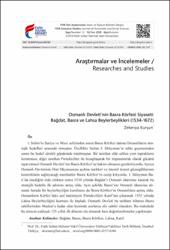| dc.contributor.author | Kurşun, Zekeriya | |
| dc.date.accessioned | 2018-12-26T14:08:49Z | |
| dc.date.available | 2018-12-26T14:08:49Z | |
| dc.date.issued | 2018-12 | |
| dc.identifier.citation | KURŞUN, Zekeriya. "Osmanlı Devleti’nin Basra Körfezi Siyaseti: Bağdat, Basra ve Lahsa Beylerbeylikleri (1534-1672)." FSM İlmî Araştırmalar İnsan ve Toplum Bilimleri Dergisi, 12 (2018): 1-27. | en_US |
| dc.identifier.uri | http://dergipark.gov.tr/fsmia/issue/41565/502145 | |
| dc.identifier.uri | https://hdl.handle.net/11352/2825 | |
| dc.description | Araştırma makalesi | en_US |
| dc.description.abstract | I. Selim’in Suriye ve Mısır seferinden sonra Basra Körfezi daima Osmanlıların stratejik hedefleri arasında olmuştur. Özellikle Sultan I. Süleyman’ın tahta geçmesinden sonra bu hedef sürekli gündemde tutulmuştur. Bir taraftan elde edilen yeni toprakların korunması, diğer taraftan Portekizliler ile hesaplaşarak bir imparatorluk olarak gücünü ispat etmesi Osmanlı Devleti’nin Basra Körfezi’ne hakim olmasını gerektiriyordu. Ayrıca
Osmanlı Devletinin Hint Okyanusuna açılma istekleri ve önemli ticaret güzergâhlarının
kontrolünün sağlayacağı menfaatler Basra Körfezi’ni cazip kılıyordu. I. Süleyman Batı’da
istediğini elde ettikten sonra 1534 yılında Bağdat’ı Osmanlı idaresine katarak bu
stratejik hedefin ilk adımını atmış oldu. Aynı şekilde Basra’nın Osmanlı idaresine alınarak burada bir beylerbeyliğin kurulması da Basra Körfezi’ni Osmanlılara açmış oldu. Osmanların Körfez’deki asıl hakimiyeti Portekizlileri Katıf’tan çıkararak 1555 yılında Lahsa Beylerbeyliğini kurması ile başladı. Osmanlı Devleti bu tarihten itibaren Basra sahillerinden Maskat’a kadar olan kesimde asırlarca söz sahibi olacaktır. Bu makalede bu sürecin yaklaşık 125 yıllık ilk dönemi ele alınarak bazı değerlendirmeler yapılmıştır. | en_US |
| dc.description.abstract | The Persian Gulf had always been among the strategic aims of the Ottomans since Selim I’s Egypt campaign. Much more attention had been devoted particularly with Suleyman I. The Ottoman Empire had to have sovereignty over the Persian Gulf because of two important reasons: first it had to retain the newly conquered lands and second to prove its power as an empire by facing with the Portugese. Moreover, reasons such as reaching to the Indian ocean and controlling significant trade routes made the Persian Gulf much more attractive. Suleyman I’s taking control of Baghdat in 1534 after accomplishing his aims in the West was the first step towards these strategic aims. Similarly, the control of Basrah by the Ottomans and the establishment of a beylerbeylik there also paved the way for the opening of the Persian Gulf to the Ottomans. However, it was only after the Ottomans forced the Portugese out of Qatif and established the Lahsa beylerbeylik
in 1555 that the real control in the Persian Gulf had been established. It is after this date the Ottomans became an important actor in the region from the coasts of Basrah to Musqat for centuries. This paper deals with the first period (125 years) of this rule and makes some evaluations. | en_US |
| dc.language.iso | tur | en_US |
| dc.publisher | FSM Vakıf Üniversitesi | en_US |
| dc.rights | info:eu-repo/semantics/openAccess | en_US |
| dc.subject | Bağdat | en_US |
| dc.subject | Basra | en_US |
| dc.subject | Basra Körfezi | en_US |
| dc.subject | Lahsa | en_US |
| dc.subject | Katıf | en_US |
| dc.subject | Bagdhat | en_US |
| dc.subject | Basrah | en_US |
| dc.subject | Persian Gulf | en_US |
| dc.subject | Lahsa | en_US |
| dc.subject | Qatif | en_US |
| dc.title | Osmanlı Devleti’nin Basra Körfezi Siyaseti: Bağdat, Basra ve Lahsa Beylerbeylikleri (1534-1672) | en_US |
| dc.title.alternative | Persian Gulf Policies of the Ottoman Empire: Beylerbeyliks of Baghdat, Basrah and Lahsa (1534-1672) | en_US |
| dc.type | article | en_US |
| dc.contributor.department | FSM Vakıf Üniversitesi, FSM İlmî Araştırmalar İnsan ve Toplum Bilimleri Dergisi | en_US |
| dc.relation.publicationcategory | Makale - Ulusal Hakemli Dergi - Kurum Öğretim Elemanı | en_US |



















